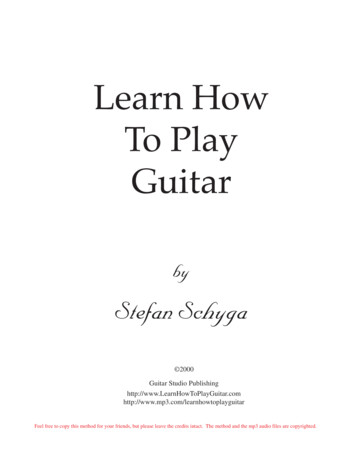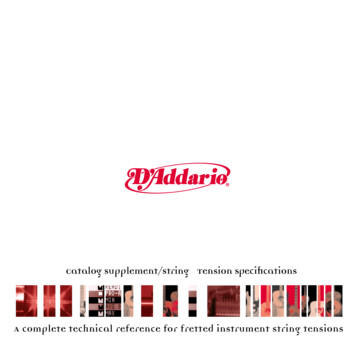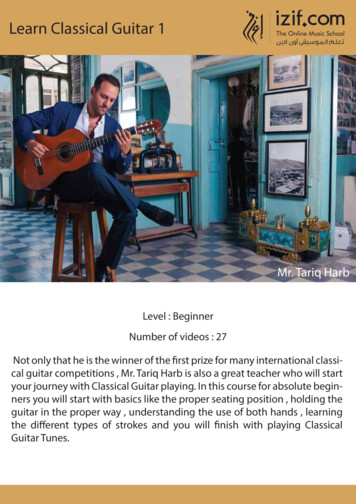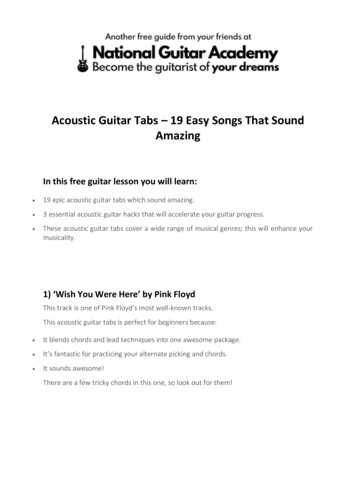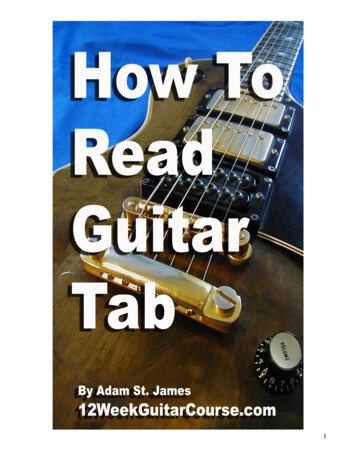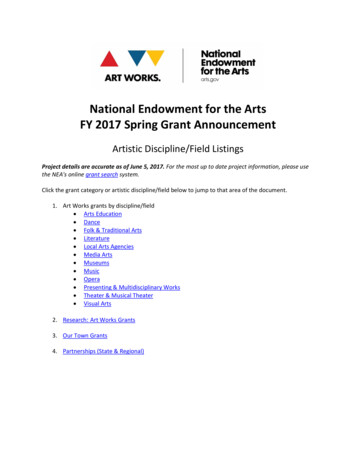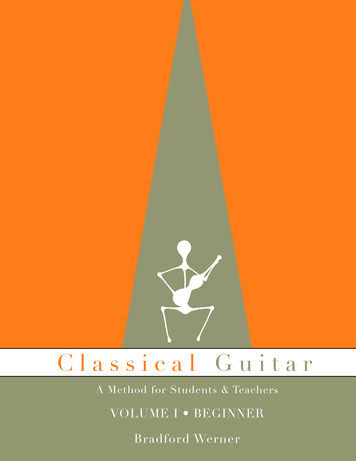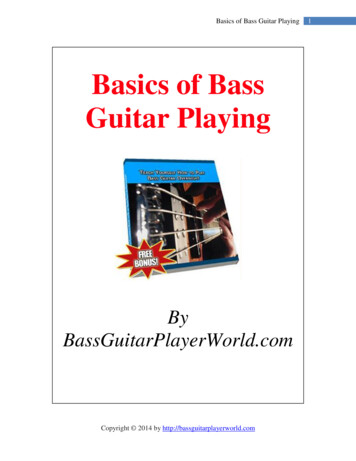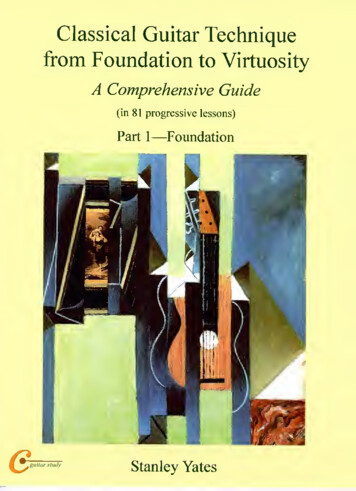
Transcription
Classical Guitar Techniquefrom Foundation to VirtuosityA Comprehensive Guide(in 81 progressive lessons)Part 1—FoundationStanley Yates
Classical Guitar Techniquefrom Foundation to Virtuosity— A Comprehensive Guide —(in 81 Progressive Lessons)Stanley YatesPart 1 — FoundationCGSE-0040-1Classical Guitar Study EditionsCopyright 2016 by Stanley YatesTN, USAAll Rights Reserved1/LLISBN-13: 978-15-3969-767-1ISBN-10:15-3969-767-3BISAC: Music / Musical Instruments / Guitar
FOREWORDWith this work, Stanley Yates goes beyond the traditional concept of the guitar methodor the guitar technique treatise. The history of the instrument includes outstandingexamples, but none that constitutes an adequate precedent to this book from the AngloAmerican master. From Sor to Pujol, from Aguado to Carlevaro, the most importantauthors have always and in every way operated within a well-defined historical andaesthetic purview. This infused their work with character, but also marked its limits.Yates, on the other hand, examines guitar technique and its related musical situations asa series of 'objects' for investigation under an approach that I do not hesitate to callphenomenological (referring to the teaching of Edmund Husserl and the masters of theSchool of Brentano). He puts forward intuitive experience and emphasizes the value ofobservation, accepting that these arise from one's point of view—without, however,raising the problem of subjectivity. He tends, therefore, toward a kind ofepistemological awareness which does not stop at observation, but which points to thevery essence of our act of experiencing and learning. In other words, his work is posedin terms of a knowledge that transcends itself, wrapped up in the phenomena ofinstrumental music-making (only guitar technique is dealt with, but there would be noobstacle to employing this phenomenology in the realms of piano or voice).
Pre-Publication Endorsements for Classical Guitar Techniquetogether, the author offers us a sequential, rigorously calibrated and breathtakinglycomprehensive pedagogical resource for the classical guitarist. From the most basicelements of playing to the most difficult and sophisticated techniques in current use,Yates gives thoughtful, scholarly and above all, practical lessons. His love of both theexpressive possibilities of our instrument and the tactile experience of playing it are asobvious as is his mastery of the process by which virtuosity is achieved. This book maywell be the indispensable method."Stephen AronChair Guitar DepartmentOberlin Conservatory of Music"The product of a lifetime of self-critical, analytical, and insightful artistry and teaching,Yates' magnum opus is the most thoroughly comprehensive guitar technique manualI've ever seen. One finds here many of the guiding principles found in the masterfulteachings of Patrick O'Brien, as well as concepts of body usage one learns in the studyof the Alexander Technique. The presentation is logical, and easy to follow. This workcontains something of value for even the most advanced students and teachers of theinstrument, and a great deal more."Dr. Douglas JamesChair Guitar DepartmentAppalachian State University"The great guitarists make it look easy. The question is how did they achieve such ahigh level? Finally, the answer is found in Classical Guitar Technique from Foundation toVirtuosity. Unlock the path to developing a graceful and musically expressive playingtechnique."Bill PibumEditorFingerstyle Guitar Journal"This monumental work by Stanley Yates is both a lucid summation of guitarmethodologies and an innovative advancement of instrumental theory. Read it andMark DelprioraChair Guitar DepartmentManhattan School of MusicInstructor Undergraduate StudiesThe Julliard School
ContentsCONTENTSPrefaceIntroductionTechniqueWhat is Technique?Developing and Practicing TechniquThe Necessity of Optimizing Fundamental Technique What are MovementForms? The Process of Optimizing a Movement Form Refining FaultyAdditional Thoughts.Technique or Natural Facility? Modeling Nature? Tension or Relaxation? Balance and Weight Compound Movements (Gestures) Hands Separately Ease of Execution Awareness and Sensation Putting the Idea Before theExecution and the Power of the Inner Ear Balance in All Things AvoidingInjury and Optimizing Playing Longevity The Individual About theMetronome Keeping a Practice JournalUsing this Book.A Necessary Acknowledgement.PART 1—FoundationIntroduction.25Organization of the Right- and Left-Hand Sections A Word About the Lessons Practice Routines and ContextualizationPreliminariesDaily Technical Practice and Warm-Up Routines29Up Full Warm-Up Comprehensive Technical Warm-Up When No Warm-Upis Possible After Practicing Establishing a RoutineSitting-Position.34
Contents1 Hand Position and Plucking Acti1 The Basic Right-Hand Position.Forming the Basic Playing Position Position of the Fingers Relative to the Strings Position of the Thumb Relative to the Strings Balancing the Thumb and Fingers—5 Refining the Basic Stroke.Defining Tension-Levels Preparing the Stroke Moving Through the Strings andFollow Through Returning to the Strings Legato—Returning and Preparing Closeto the Strings Consistency of Sound Practice Routine and Contextualization
Contents4 Other12 Tremolo .91Technical Development Sequence Hand Position am Compound Stroke ami —amip—pami at Speed Staccato Practice Practice Routine and Contextualization13 Rest Stroke.98Rest Stroke with the Fingers Single-Finger Rest Stroke String Crossings FreeStroke / Rest-Stroke Mixture- Practice Routine and Contextualization14 Introductory Rasgueado Exercises.103Single-Finger Strumming Basic cami Rasgueado Practice Routine andContextualizationThe Left HandIntroduction.1071 Hand Position15 Basic Position of the Left Hand and Arm.109Forming the Basic Playing Position The Left-Hand Thumb16 Refinement of the Basic Position.112Parallel Position Rotated Position The Lower Position Hyper-Parallel Position Favoring the Weaker Fingers Placing Block Chord Shapes Changing BetweenChords in Arpeggio Textures (Sequential Finger Placement) Practice Routine and17Barres.Developing the Technique Arm Weight and the Upper-Arm Muscles FingeringTips Further Barre Types Maintaining Barres Over Extended Time Spans PracticeRoutine and Contextualization2 Independence and Coordination18 Precision, Tension, Coordination, and Independence.Independence - Practice Routine and Contextualization19 Touch (Sensitivity) and Independence Exercises.Melodic Chordal Practice RoutineLegato Finger12412820 Melodic Coordination Exercises.130Preliminary Exercises The Common Finger-Combinations Practice Methods Practice Routine and Contextualization21 Independence Between the Hands. ,.138Combining Disparate Finger Groupings Between the Two Hands Practice Routine22 Intervallic Coordination Exercises.140
Conte24 Shifting Along the Strings.27 Ascending Slurs.157Fingers Finger Pairs Three and Four-Finger Groups Controlling 'Fly-away'Fingers Slurring from Open-Strings Practice Methods Practice Routine28 Descending Slurs.164The Slurring Finger Finger-Pairs Simultaneous Placement of Fingers PracticeRoutine29 Three- and Four-Finger Descending Slurs.168The Three-Finger Diatonic Figures 421 and 431 The Four-Finger Chromatic Group30 Compound SlursAscending-Descending Compound Slurs Descending-Ascending Compound Slurs Practice Routine and Contextualization171Appendices1 — Full Warm-Up Routine.1752—Tuning.181Common Tuning Methods F.qual Temperament Equal-Temperament TuningMethod Biased Tunings Dealing With Scordatura Tuning in PerformanceIn Part 2 of Classical Guitar Technique (Mastery and Virtuosity).Critically-Acclaimed Editions by Stanley Yates.193
PREFACEEvery performer in each practice session gains insight into some aspect of their work.The same can surely be said for every teacher in each lesson. Several years ago, as aperformer and as a teacher, I began making notes about these kinds of things. I'm sure thatmany other performers and teachers have done the same.What a pity it is that these things almost always go unpublished. Still, the reason for this ispretty clear. How do we make this kind of information useful to others, or even toourselves? While we might arrange our ideas under a few general headings—'circulararpeggios,' 'fast scales,' 'cross-string ornaments'—how useful would such a collection oftidbits be to someone searching for a systematic way of developing their playingtechnique? For this kind of information to be truly useful, an underlying organization andmethodology is needed, and this has been the principal challenge in writing this book.While not intended to be a method book, the exploration of guitar technique presentedhere nevertheless takes the form of a series of self-contained lessons, foUows a sequentialplan, and attempts to tie playing technique to musical context (something that's essentialfor technique to be deeply internalized and truly useful).Representing my experience as a concert performer, masterclass teacher, universityprofessor, and self-teacher (as we all ultimately are) this book reflects not only what I'velearned through my own technical development, but also what I've learned throughhelping student guitarists find solutions to their own problems of developing reliable andmusically-effective playing technique. Through all of this, I do realize that playingtechnique is ultimately a personal matter, that each of us determines what does or doesn'twork. Still, this doesn't mean that fundamentally-effective technical concepts and practicetechniques differ from player to player—I doubt that anyone ever got very far withoutsomehow coming across them.But what is playing technique, exactly? In the Introduction to this book, I describe what Iconsider playing technique is, along with how it may be conceptualized, developed,practiced, internalized, applied, and maintained. I distinguish between fundamentalmovement forms (the movements that make up the basic playing actions of each hand) andthe more sophisticated movement forms and combination of the hands required foradvanced technique and mastery of the instrument—this book falls into its two main partsalong these lines.While approaching virtuosity, this book is intended to be useful to any serious player whowishes to develop and refine their playing technique, at whatever stage of developmentthey may find themselves. Furthermore, advanced players will probably gain as muchdevelopment of their existing technique from the first part of this book (Foundation) asfrom the second (Mastery and Virtuosity). I also hope that teachers will find this bookuseful as a source of technical and pedagogical information.One final point, essential to mastering any complex activity: our goal is simply to makedifficult things easy—we're able to do easy things extremely well.
-
INTRODUCTIONTechniqueIn the broadest sense of the term, technique is nothing more than a way of going aboutthings, an approach to tackling something that's in some way beyond our natural,unpracticed capability. As musicians, our technique, in this sense, is simply ourapproach to playing our repertoire well. A further common use of the term is found inassessments of this or that player as having 'poor technique/ 'good technique,''amazing technique'—usually descriptions of the accuracy level and appearance ofeffortlessness in performance.None of these uses of the term tells us much about what playing technique actually is.More specifically, instrumental technique may be defined as a set of internalized(automated) movement forms.While many movement forms are possible, only relatively few of them are required forthe majority of technical events that present themselves in any particular piece of music.One may wonder, then, why can't we simply internalize this select group of movementsand immediately play any given piece without practicing it? The answer, of course, isthat there are an almost limitless number of ways in which the movement forms can becombined with one another—in the same way that from a relatively small number ofmusical shapes an almost limitless number of unique musical compositions may becreated. This unique and constantly varying collection of movements presents the maintechnical challenge to internalizing (learning) any particular piece of music.Movement forms, however, can be of variable quality, depending on how they've beeninternalized. This suggests that a first goal of technical development is to internalizereliable versions of the forms required for playing the guitar, with thefurther goal of developing an efficient means of applying them in a given musicalThe process of developing technique would therefore appear to consist of determiningwhat the fundamental movement forms are, adopting an efficient way of internalizingthem, and developing a systematic way of applying them to the music we wish to play.But there's more to technical development than this. Consider, for example, what'sneeded to play the following passage effectively (an excerpt from an easy-intermediateV rlSixT 'iBeyond producing a pleasing tone, changing smoothly to each new chord withoutextraneous noise or breaks in legato, and not missing any of the notes, there's also theWhat is Technique?
Introductioneed for fine control of the relative dynamic levels and timbre of the bass, melody, andaccompaniment, and fine control of dynamic and rhythmic nuance associated with theshape of the phrase, its note groupings, and the relative degrees of tension created bythe harmonic progression. Clearly, playing technique is inseparable from musicalexpression.While it's possible, in theory, to develop an efficient mechanical playing techniqueentirely through the study of abstract exercises, this technique would be almost uselessfor performing a piece of music. Musical shapes are so filled with rhythmic, dynamic,and timbral nuance that, at any given point in a composition, a myriad of subtletechnical events are taking place simultaneously.Since, presumably, no one wishes to play music inexpressively, the process ofdeveloping technique must ultimately be tied to musical shapes. Our goal isn't simplyto develop a reliable and comfortable finger technique; it's to develop an organictechnique responsive to expressive musical demands as well—a musically-sensitiveBefore we can begin to look at ways of developing technique, as we have now definedit, we must acknowledge that it cannot be developed in a musical vacuum.We can also consider technique in a performance context: the technique required for a detaildistinction along these lines between solo performance on the one hand and chamber andconcerto performance on the other).Developing and Practicing TechniqueThe Necessity ofOptimizingFundamentalTechniqueThe central goal of technical work is to develop control, ease, and flexibility in all areasof our playing. Without these essential qualities advanced technique is out of reach,difficult passages are unplayable, expressive playing is unattainable, and even thesimplest passages remain unreliable.An optimized technical foundation allows us to play all of our basic technical eventswith control, ease, and reliability; it provides the foundation needed for developingadvanced techniques, for playing complex technical events and, ultimately, forvirtuosity. Most importantly, ease and control provide the flexibility needed to makedetailed musical gestures and to play music expressively.No different than any other system, the effectiveness of our technique is determined byits weakest link, and the more fundamental that link, the less effective the whole. It'stherefore necessary not only to develop an optimized foundation technique, but also toconstantly revisit, refine, and maintain it.Since the most important aspects of our technique are the most basic ones—our handand arm positions, the way we place our fingers on the strings and our internalizedfundamental movement-forms—these aspects have to be honed to a precise level,optimized, maintained, and constantly refined if our playing technique is to be trulyeffective.
IntroductionEach new piece we adopt, on the other hand, provides us an ideal opportunity tointernalize an optimal technical version of it, one that won't require a time-consumingAlthough our technique becomes increasingly internalized (second nature) it'snevertheless important that we consciously maintain it. Basic movement forms can bemaintained through a daily warm-up routine (a later section deals with this). Moreadvanced movement forms can be maintained by periodically working on an adoptedcomfortable study or other appropriate piece that uses it relentlessly. For example, tomaintain an optimized descending-slur technique one could use Fernando Sor's Op. 6 No.3:MaintainingInternalizedTechnique1mf(echo)The idea is to carefully learn the study with optimized movements, sensations, andexpression, and periodically rework it to maintain the technique it deals with. Overtime, we accumulate a focused set of studies that address and maintain the main areasof our technique. Repertoire suggestions along these lines are provided throughout thevarious sections of this book and have been taken from standard repertoire etudes andother appropriate pieces that all guitarists surely study and play. This kind of repertoireshould be involved enough to require a fully internalized version of the technique itmajority of studies and other repertoire recommended for maintenance are of anAvoid the mistake of thinking that fundamental technique can be developed solely byplaying studies; studies are for maintaining and combining movement forms with oneAdditional ThoughtsWe've all been inspired by the transcendent abilities of iconic performers, and it7sonly natural—and to an extent, desirable—that we would wish to emulate whatwe can discern of their technique, musicianship, and artistry. When it comes to playingtechnique, though, much of it is invisible to the observer; most of it exists for theperformer only, as physical and psychological sensation. The way something feels, atleast to an experienced player is far more relevant to developing technique than howsomething looks.Is it possible that an iconic player may play well despite their technique? Individualswho possess a high degree of natural coordination, fine motor skills, and quick reflexes,having necessarily found the easiest, most efficient way of doing things. In other words,an accomplished performer may possess a high degree of natural facility and personalmotivation but a less than optimally-developed instrumental technique in the sense ofhaving found the easiest possible way of doing things.Technique orNatural Facility?
IntroductionEase of ExecutionPlaying the guitar, at first, isn't easy. But it must become so—otherwise we could neverdo it well.One approach to technical development (or learning a new piece, for that matter) is theelimination of difficulties. Even better, though, is to not allow difficulties to occur in thefirst place. We experience difficulty when we haven't accurately internalized ourtechnique, when we practice too quickly and without full awareness, or when we workon material that's distant from our internalized technique. The most productiveapproach to technical development is to practice in such a way that everything is easy,and the way to achieve this is to work on musical segments that are short enough toplay with full awareness. I discuss practice methods in detail throughout this book, butsuffice it here to say that the goal of technical practice is to discover the easiest, mostcomfortable way of reliably meeting our musical objectives.Awareness andSensationAs already mentioned, much of what we perceive as technique while playing is a vagueseries of sensations in the hands and arms. Through practice we learn to associate theidea of a movement form with the physical sensation required to execute it, and it'stherefore essential that we undertake our technical practice with a good deal ofawareness of how things actually feel. As an example, pick up your guitar and, withoutthinking much about it, prepare to play the following descending slur (but withoutactually playing it): 2 /Now, stop and gauge the amount of tension present in your left-hand fingers, thumb,hand, arm, and shoulder. Is it possible to reduce some of it? (If it isn't, congratulations!)Likewise, prepare to play the following chord, but just before you're about to do so, sfzAgain, register the amount of tension in your right-hand fingers, hand, arm, andshoulder. Could you have prepared for this action with more comfortable sensations inthe various parts of the hand and arm?Unless you already possess a highly-developed playing technique, it's unlikely that youwere able to prepare to execute these basic technical events with only the minimum ofnecessary tension; more likely, you were easily able to discover a more comfortable, lesstense sensation that allowed you to feel prepared to execute the movement. Hopefully,you also registered a feeling of lightness, security, and balance that's now available foryou to recall mentally if you retry the experiment.
IntroductionWe must constantly monitor our practice, isolating elements and assessing how theyfeel (playing eyes closed as part of our practice is an effective way of achieving this).Effective practice begins with an idea, and the clearer the idea the better the execution.By imagining (visualizing) a movement before executing it we increase our awareness ofhow it actually feels and we are better equipped to assess the result. Just as important, isthe need to audiate (hear the musical sound mentally) before playing. Careful listening isessential to developing playing technique—it directs our fingers to create the sounds,rhythms, and nuances present in our inner ear. Not only do visualization and audiationevoke the required internalized movement-forms, they also provide a yardstick withwhich we may assess our sound and expression during practice and performance.Putting the IdeaBefore theExecution andthe Power of theBoth practice and performance are as much psychological activities as they are physicalones, and much physical practice can be augmented (or even replaced) by purelyvisualized practice, as many professional musicians can confirm.The necessity of achieving a balance in all aspects of life is a cornerstone of manyphilosophies. It can also be a cornerstone of our approach to playing the guitar. Almostany dialectic we can imagine has a potential application to our analysis, study, andpractice: fast-slow, loud-soft, crescendo-diminuendo, accelerando-ritardando, tenserelaxed, analytic-intuitive, a ware-internalized, visualize-act, rest-movement, isolatesynthesize, and so on. A simple but powerful approach to technical development is todetermine which side of a dialectic relationship we are on, and balance it with anexploration of its opposite. For example, to develop a relaxed slurring technique explorehow it feels to play a slur with tension; to play with good coordination between the twohands, explore each hand separately; to play fast, practice slow, and so on. If we findourselves between two opposites, we've either achieved a balance or we may bedoing nothing useful at all.Balance In All ThingsModeration is a further outcome of a dialectic approach: we moderate our impatientdesire for the long-term goal of mastery by patiently mastering many small short-termgoals along the way, we moderate our desire to practice for three hours at a time bypracticing for one hour three times over the course of the day, and so on.Of course, there's no such thing as perfection, only the attempt to achieve it.While playing a musical instrument doesn't require the athleticism of a tri-athlete, it's aphysical activity nonetheless and, due to the repeated and prolonged use of smallmuscles and other delicate tissues, one that makes us susceptible to strain injuries thatcan be incapacitating. Injuries of this type often result from over-practicing duringperiods of intense study, but can also appear simply due to years of inappropriatepractice, inefficient technique, or both.We can eliminate the potential for injury by avoiding marathon practice sessions(several sessions of 45 60 minutes spread over the day is appropriate), by warming-upsufficiently before practicing and stretching after practicing, by using mental as well asphysical practice, by taking the steps necessary to fully optimize all areas of our playingAvoiding Injury andOptimizing PlayingLongevity
IntroductionUsing this BookAll who wish to use this book should should work through all of the lessons in theorder presented, no matter what your present technical level (for advancedplayers, much of this will not take very long). As mentioned earlier, not only will thisprovide an opportunity for you to assess your technique as it presently exists, it willalso provide an opportunity to refine it.Lessons from the Right-Hand sections should be studied together with lessons from theLeft-Hand sections, though the lessons within each section should be studied in thesequence presented. Part 2 shouldn't be studied until the material in Part 1 is genuinely
IntroductionThis Introduction is followed by a Preliminary section that addresses Daily TechnicalPractice and Warm-Up Routines, Sitting Position, and Tuning. Part 1 concludes with asection of Appendices that contain a sample Full Warm-Up Routine, additionalinformation regarding Tuning, and a number of Practice Grids to help keep track of thevarious lesson Practice Routines. Part 2 concludes with appendices dealing with SpecialEffects, Fingering Guidelines for the two hands, the Technical Approach to Learning aNew Piece, an overview of Iconic Method Books and Study Sets, and further PracticeGrids.A Necessary AcknowledgementNo one develops their ideas in a vacuum. During the formative years of myon the topic. This included publications by historical writers as well as modem ones,my observations of iconic performers, and the ideas I received from my teachers. Manyyears, concerts, and students later, much of this information has become second natureto me. Still, the ideas in this book have been influenced by many guitarists and by many it the following websites to download blank Practice Grids, foi
PartiFoundation
Introduction to Part 1Introduction to Part 1Part 1 of Classical Guitar Technique deals with fundamental movement-forms and thepractice methods used to develop and internalize optimal versions of them. Thismaterial provides the foundation for the advanced techniques and practical applicationsdeveloped in Part 2.Without the internalization of optimized versions of the fundamental movement-forms,advanced technique is a virtual impossibility (at least if it is to be controllable andreliable); careful study of the basic forms is therefore essential to the overalldevelopment of effective playing technique.The preliminary material dealing with Daily Technical Practice and Warm-Up Routines,Sitting Position, and Tuning, is followed by the two main sections that make up Part 1of Classical Guitar Technique. These deal with the right and left hands respectively. Thetopics in these sections are organized sequentially and build upon one another; it'stherefore important that the lessons within each section be studied in the orderpresented. Lessons from the right- and left-hand streams should however be studiedtogether (daily technique sessions therefore contain something for each hand.Organization of theRight and Left-HandSectionsPart 1 ends with 3 appendices, the first providing an example of a full warm-up routine,the second dealing with further issues relating to fine tuning, and the third providingPractice Grids to help you track your progress through the various lesson PracticeRoutines.The early lessons in each main section contain relatively few exercises and are primarilydescriptive and explanatory. The issues explored, however, are fundamental to effectivetechnique and it's important that they are explored and understood. Subsequent lessonsAllow each lesson the period of time it needs; this may range from a few days to severalweeks (or even longer). Each lesson stream—right hand or left—will therefore progressat its own pace. Once a lesson has been absorbed move onto the next one in that stream.Likewise, once you reach the end of a stream, continue onto the lesson stream for thathand in Part 2 (or take the opportunity to revisit earlier lessons you feel may need morework).Should a lesson or exercise remain troublesome after a few weeks of practice, make anote of this and move on. You can revisit it at a later time, at which point it will almostcertainly progress more easily.A Word Aboutthe Lessons
Preliminaries
Daily Technical Practice and Warm-Up RoutinesDaily TechnicalPractice andWarm-UpsExpert players are experts at practicing.technical practice sessions preparing to practice—state of mind and physicalpreparation the importance of warming-up warm-up template warm-uproutinesWhile a comprehensive exploration of practice methods and routines wouldrequire a book-length study in itself, it's necessary here for us to take a look atthe main issues regarding daily practice as they relate to technical development.While the main reason for practicing an instrument is to learn and play music, at leastsome technical work should be part of daily practice, whether it be a warm-up, a lessonfrom this book, or some other type of technical practice session.In terms of this book, a technical practice session consists of a short warm-up followedby work on a Right-Hand Lesson and L
Finally, the answer is found in Classical Guitar Techniquefrom Foundation to Virtuosity. Unlock the path to developing a graceful and musically expressive playing technique." Bill Pibum . . here nevertheless takes the form of a series of self-contained lessons, foUows a sequential plan, and
